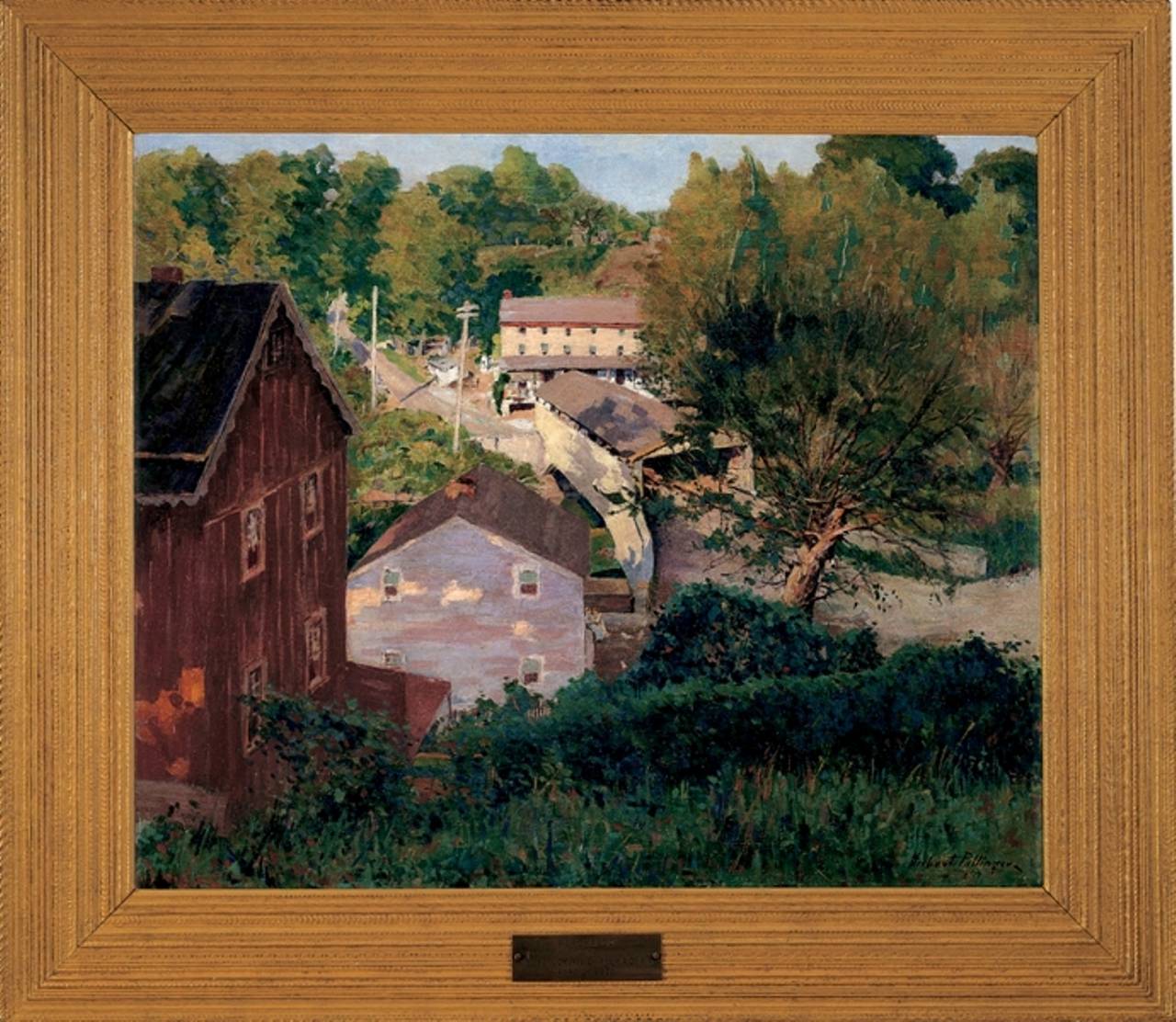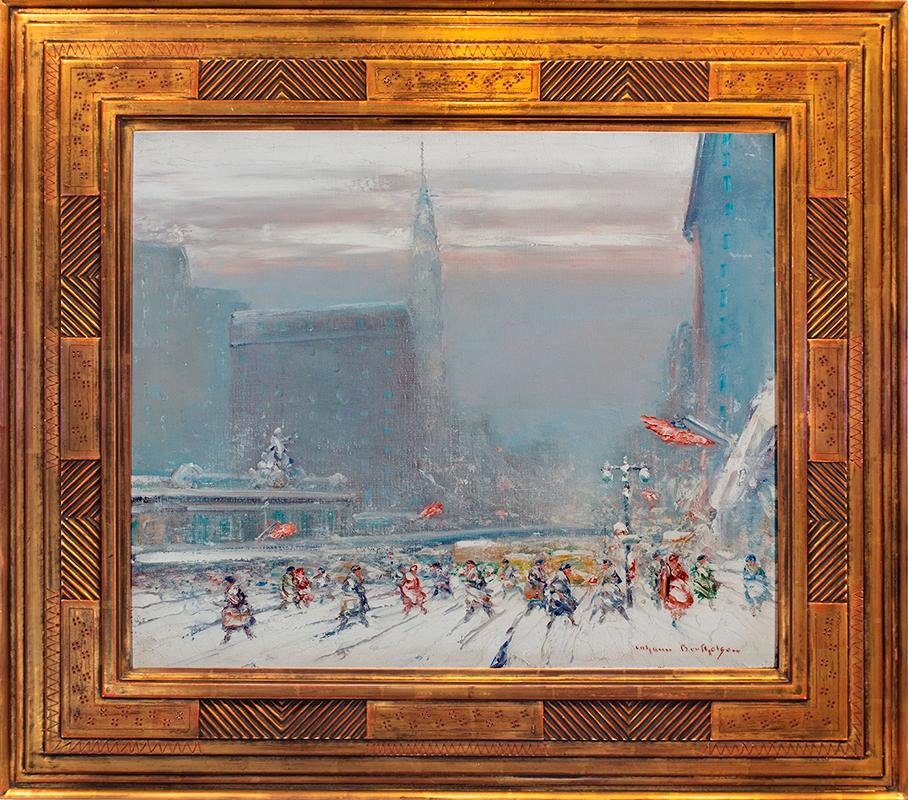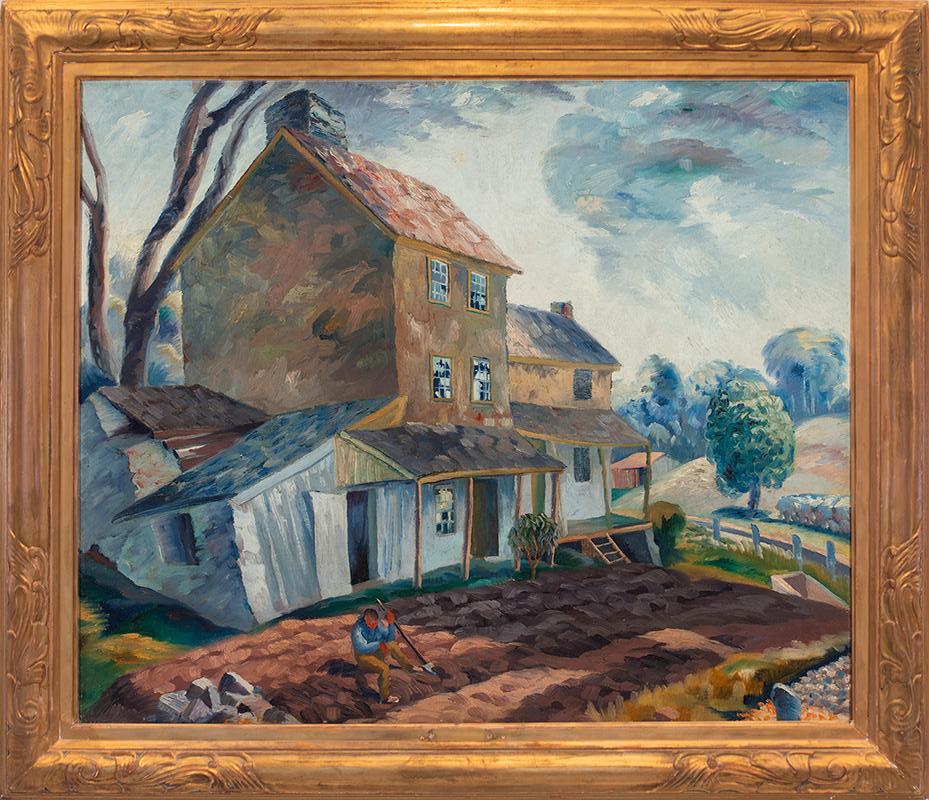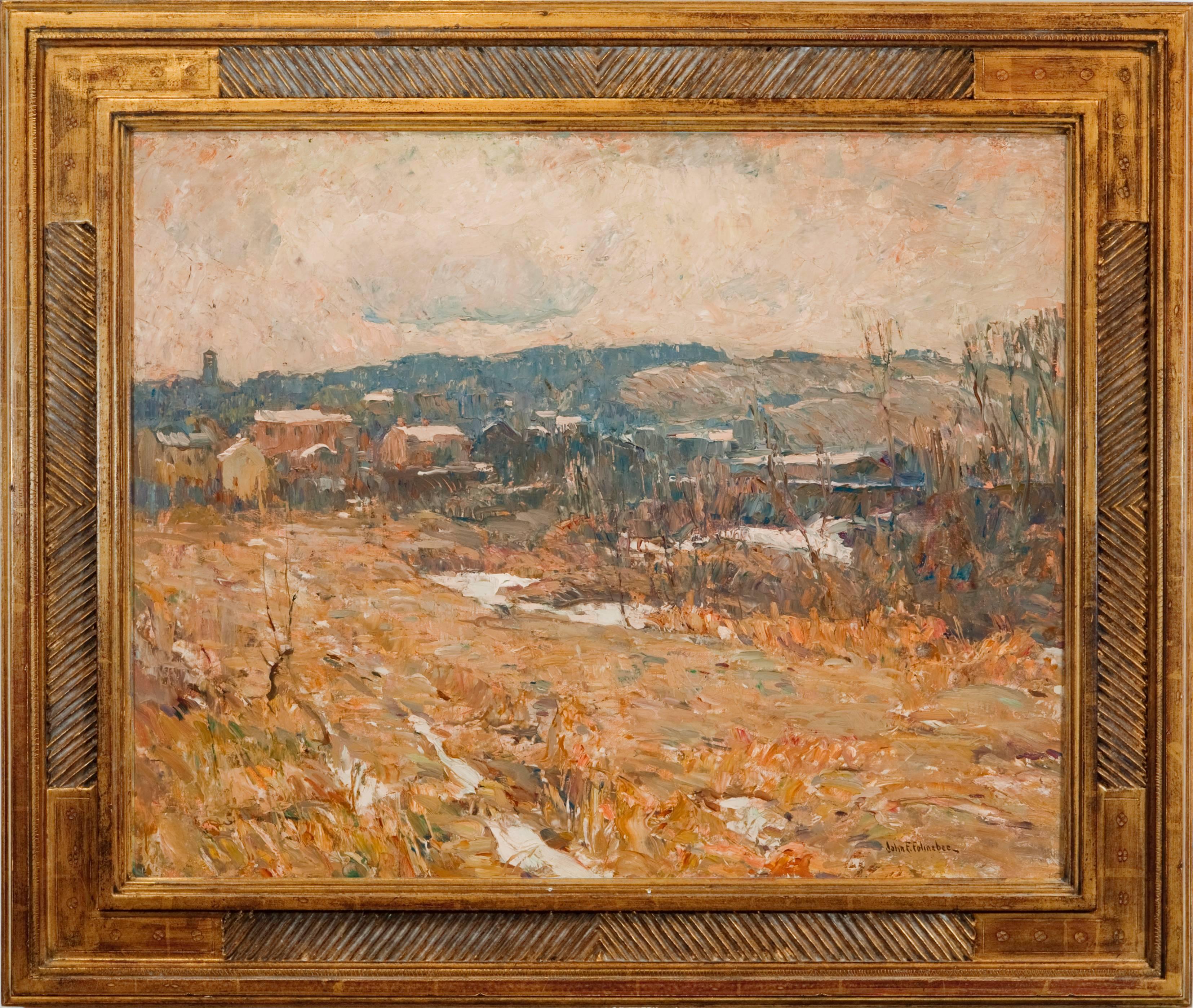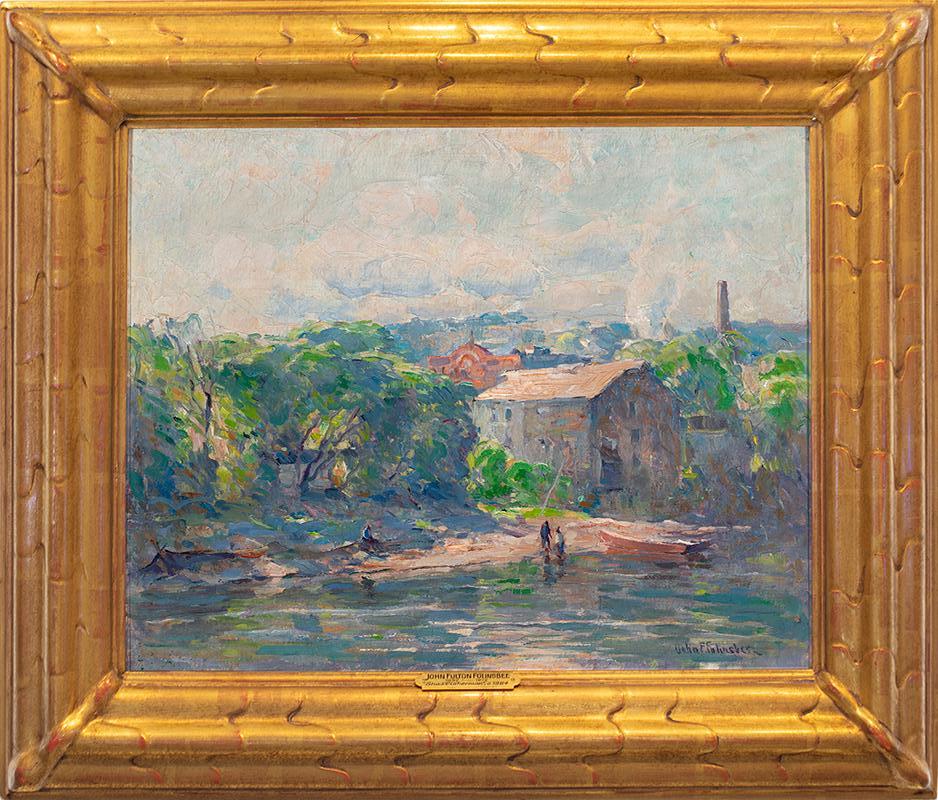Items Similar to "Spanish Mission in Florida, " Anthony Thieme, Cape Ann Impressionist
Want more images or videos?
Request additional images or videos from the seller
1 of 8
Anthony Thieme"Spanish Mission in Florida, " Anthony Thieme, Cape Ann Impressionist
About the Item
Anthony Thieme (1888 - 1954)
Spanish Mission, Florida
Oil on canvas
25 x 30 inches
Signed lower left; titled on the reverse
Anthony Thieme was born in the Dutch port city of Rotterdam in 1888. He studied at the Academy of Fine Arts in Rotterdam, at the Royal Academy at the Hague, as an apprentice to George Hoecker, a well known stage designer in Düsseldorf, Germany, and to Antonio Mancini, an Italian Impressionist. After completing his studies, Thieme journeyed throughout Europe and South America, working in stage design to support his travels. Thieme first came to the United States in 1917 and initially worked as a set designer and book illustrator first in New York and later in Boston.
By the late 1920s, Thieme had married and moved from Boston to Cape Ann in Rockport, Massachusetts, an emerging art colony. Like the other Rockport artists, his style was influenced by Impressionism, with special attention paid to the effects of light, but also by the Dutch tradition of seascape painting. Throughout his career, Thieme favored painting en plein air, or outside, because it allowed him to better capture the atmosphere's fleeting effects. He has been referred to as the "Master of Light and Shadow."
Thieme's paintings were often met with critical acclaim and were displayed at galleries in New York, London, and Paris. He also established the Thieme School of Art at Cape Ann in 1929 and taught classes out of his studio until 1943. Tragedy struck in 1946 when his studio burned to the ground, destroying much of the work he had produced over thirty years. Devastated by this loss, Thieme left Massachusetts in search of new adventures and inspirations. He traveled south to Charleston, South Carolina and was greatly inspired by the dense, tropical foliage and the warm, coastal light. He spent two months in Charleston, painting prolifically, before continuing on to Florida, the Caribbean, and Central America. Until his mysterious death in 1954, Thieme spent his summers in Rockport and the winter months based in St. Augustine, Florida.
Throughout his career, Thieme exhibited his work widely and was active in numerous art associations and clubs. He participated in exhibitions across the country including ones at the Pennsylvania Academy of the Fine Arts, and the Corcoran Gallery in Washington, D.C. He was a member of the National Arts Club, the American Watercolor Society, the Salmagundi Club, the Boston Art Club, the Art Alliance of America, and the Rockport Art Association.
- Creator:Anthony Thieme (1888 - 1954, American)
- Dimensions:Height: 33 in (83.82 cm)Width: 38 in (96.52 cm)
- Medium:
- Movement & Style:
- Period:
- Condition:
- Gallery Location:New York, NY
- Reference Number:1stDibs: LU184129924002
Anthony Thieme
Anthony Thieme was born in Rotterdam, Netherlands, on February 20, 1888. After traveling in Europe, England and South America, Thieme settled in Boston. He established a studio in Rockport on Cape Ann. Thieme became very well known for his seascapes and shore scenes. He established the Thieme School of Art in Rockport, of which he was the director. Thieme died on December 6, 1954, in Greenwich, Connecticut.
About the Seller
5.0
Platinum Seller
These expertly vetted sellers are 1stDibs' most experienced sellers and are rated highest by our customers.
Established in 2021
1stDibs seller since 2022
63 sales on 1stDibs
Typical response time: <1 hour
- ShippingRetrieving quote...Ships From: Larchmont, NY
- Return PolicyA return for this item may be initiated within 3 days of delivery.
More From This SellerView All
- "Soir de Novembre, Dordrecht, " Eugene Vail, Dutch Landscape with Boats, CloudyBy Eugène Lawrence VailLocated in New York, NYEugène Laurent Vail (1857 - 1934) Soir de Novembre, Dordrecht Oil on canvas 19 1/4 x 25 3/4 inches Signed lower left; titled in two places on the stretcher with various other inscriptions, stamped "MADAME G:VAIL A" and inscribed "177" in ink and "#43" in pencil on a partial label from Garde-Meuble Maple affixed to the stretcher Eugene Vail (Saint-Servan, France September 29, 1857 - Paris, December 28, 1934), the son of a French mother and an American father, Lawrence Eugene Vail, studied at the Stevens Institute of Technology in Hoboken, New Jersey (where Alfred Stieglitz was born in 1864) and graduated with a degree in mechanical engineering in 1877. Then he became a student of William Merritt Chase and J. Carroll Beckwith at the Art Students League before returning to France. He entered the Ecole des Beaux-Arts in 1882 where he was instructed by Alexandre Cabanel, Raphaël Collin, and Dagnan-Bouveret (1852-1929), known as an extreme naturalist. When Bastien-Lepage died in 1884, Dagnan-Bouveret became the leader of the Naturalist School. He definitely made an indelible impression on Vail. According to Louise Cann, Vail soon became an independent painter working at Pont-Aven and Concarneau. It is difficult to determine when he separated from his teachers since he is listed as a student whenever he exhibited at the Paris Salon — that is, until 1899 when he dropped the mention of élève. A picture of a peasant girl, Seulette was his Salon debut painting in 1883, the same year that he sent two scenes of Brittany to the Pennsylvania Academy of the Fine Arts' exhibition, which documents his stay in that region. The next year he exhibited in the Salon: Fishing Port, Concarneau, which went to the Luxembourg Museum (it is now in the Musée Municipal of Brest). It has the Naturalist brown and gray palette and tonalist atmosphere but already shows that Vail had direct experience with scenes of life in coastal villages: "So convincing was his familiarity with the French coast that the critic Thiébault-Sisson claimed him as a Frenchman and declared that no American marine painter could touch his skill." (Maureen C. O'Brien, in Blaugrund, 1989, p. 218). In 1885, Vail exhibited Inner Port at Dieppe and in the following year On the Thames (Private collection), which later won him the Grand Diploma of Honor from an international jury in Berlin in 1891. Widow, the title of Vail's entry in the Salon of 1887 (unlocated), is a striking image of a woman standing on a beach, looking out to the expanse of the ocean where her husband obviously met his end. The innocent child who looks at us may have the same fate in store for him. Then in 1888, Vail completed his masterpiece, Ready, About! a "wall-size" 94 x 125½ inch canvas. The painting won a first-class gold medal in the Salon of 1888, then at the Paris Universal Exposition of 1889, Vail won another gold medal. The first precedent that comes to mind is Théodore Géricault's colossal Raft of the Medusa of 1819 (Louvre), the celebrated romantic image of castaways about to be rescued after being lost at sea. But while Géricault presents a massive, sculpturesque group of figures struggling on a raft just beyond our designated viewing space, Vail pulls the viewer into the picture, or more exactly, extends the diagonally rocking boat into the spectator's area, vividly anticipating the effects of cinematography. There is no more effective way to engage the spectator's attention and sympathies, and the illusionism is especially effective in this life-size picture. Vail's vigorous brushwork — a uniform use of rectangular strokes — adds to the motion-filled, dynamic actuality of this image, and the overall green-gray tonalities evoke the constantly menacing, cold and wet travails in the life of the fishermen in the Atlantic's rough waters. Theodore Child (1889, p. 518) wrote about this painting: "very beautiful in color, and amongst the very strongest and best pictures of this kind in the Exhibition." Dordrecht (unlocated) was Vail's painting exhibited at the Pennsylvania Academy in 1892, and in the following year he showed Fisherman — The North Sea at the Paris Salon, the same year in which he re-exhibited Dordrecht and On the Thames at the World's Columbian Exposition in Chicago. Vail won the coveted Légion d'Honneur in 1894. Some of his paintings found their way to European museums, for example, Soir de novembre (Odessa Museum) and Soir de Bretagne (Museo d'Arte Moderna, Venice). The latter was exhibited at the Exposition Universelle of 1900 in Paris. Also there was Voix de la mer (Voices of the Sea), which we identify as the painting that appears in an interior view of the American section, just to the right of a doorway (fig. 20 in Fischer, 1999), a simple marine painting. Some time after 1900, Vail turned to both impressionism and post-impressionism but no one seems to have charted this course. His Autumn near Beauvais, illustrated in International Studio (1902, p. 211), The Flags, St. Mark's Venice (1903; National Gallery of Art), and Grand Canal, Venice, ca. 1904 (Museum of Art, Rhode Island School of Design) demonstrate an impressionist technique with broken color. Mandel (1977, p. 202) wrote on the latter: "applied in short strokes juxtaposing brilliant hues of orange, blue, white, black and red, with a strong interplay between the warm pink tones of the walls and the green shadows of the black boats which are silhouetted against them." Cann (1937) believed that in Venice, Vail "found his true self." The Flags forecasts the Armistice Day pictures by Hassam and others, painted fifteen years later. Vail became involved in the Society of American Artists in Paris and the Société Internationale de Peinture et de Sculpture, whose membership included Frank Brangwyn, Charles Cottet (1863-1924), the famous Naturalist sculptor Constantin Meunier (1831-1905), Frits Thaulow...Category
Early 20th Century American Impressionist Landscape Paintings
MaterialsOil, Canvas
- "Meadow Landscape in Summer, " Harold Dunbar, Factory Scene, ImpressionismBy Harold DunbarLocated in New York, NYHarold C. Dunbar (1882 - 1953) Meadow Landscape in Summer, 1929 Oil on canvas 17 1/2 x 21 inches Signed and dated lower left Harold C. Dunbar — painter, teacher, writer, and illustrator — was born in Brockton, MA on December 8, 1882. He resided in Chatham, MA and died in 1953. His work includes portraits, landscapes, street scenes, still lifes, harbors and coastal scenes. Dunbar studied with Ernest Lee Major (1864-1950) and Joseph De Camp...Category
1920s American Impressionist Landscape Paintings
MaterialsOil, Canvas
- "Beach, Haiti, " Gifford Beal, Sunny Seascape Resort, American ImpressionistBy Gifford BealLocated in New York, NYGifford Beal (1879 - 1956) Beach, Haiti, 1954 Oil on canvas 28 x 36 inches Signed lower right Provenance: Estate of the artist Kraushaar Gallery, New York Exhibited: Youngstown, OH, Butler Institute of American Art, 1955 Lincoln, MA, DeCordova and Dana Museum, 1955 New York, American Academy of Arts and Letters, 1956 and 1960 Fitchburg, MA, Fitchburg Art Museum, 1960 New York, Art Dealers Association of America, 1963 New York, Art Students League, 1975, New York, Kraushaar Galleries, Gifford Beal (1879-1956): Retrospective Exhibition of Paintings, Apr. 29 - May 29, 1975, no. 36 New York, Kraushaar Galleries, Gifford Beal (1879-1956): A Centennial Exhibition, Nov. 6 - Dec. 1, 1979, no. 26 Gifford Beal, painter, etcher, muralist, and teacher, was born in New York City in 1879. The son of landscape painter William Reynolds Beal, Gifford Beal began studying at William Merritt Chase's Shinnecock School of Art (the first established school of plein air painting in America) at the age of thirteen, when he accompanied his older brother, Reynolds, to summer classes. He remained a pupil of Chase's for ten years also studying with him in New York City at the artist's private studio in the Tenth Street Studio Building. Later at his father's behest, he attended Princeton University from 1896 to 1900 while still continuing his lessons with Chase. Upon graduation from Princeton he took classes at the Art Students' League, studying with impressionist landscape painter Henry Ward Ranger and Boston academic painter Frank Vincent DuMond. He ended up as President of the Art Students League for fourteen years, "a distinction unsurpassed by any other artist." His student days were spent entirely in this country. "Given the opportunity to visit Paris en route to England in 1908, he chose to avoid it" he stated, "I didn't trust myself with the delightful life in ParisIt all sounded so fascinating and easy and loose." His subjects were predominately American, and it has been said stylistically "his art is completely American." Gifford achieved early recognition in the New York Art World. He became an associate member of the National Academy of Design in 1908 and was elected to full status of academician in 1914. He was known for garden parties, circuses, landscapes, streets, coasts, flowers and marines. This diversity in subject matter created "no typical or characteristic style to his work." Beal's style was highly influenced by Chase and Childe Hassam, a long time friend of the Beal family who used to travel "about the countryside with Beal in a car sketching...Category
1920s American Impressionist Landscape Paintings
MaterialsOil, Canvas
- "Winter Scene, " George Gardner Symons, Snowy Hill Landscape, PennsylvaniaBy George Gardner SymonsLocated in New York, NYGeorge Gardner Symons (1863 - 1930) Winter Scene Oil on canvas 20 x 25 inches Signed lower right Provenance: Private Collection, St. Louis, Missouri William A. Karges Fine Art Gallery, Carmel, California Private Collection, Washington A landscape and marine artist, George Symons was one of America's more noted plein-air painters who combined styles of impressionism and realism. His works are cited for their energy and simplicity, and he often did panoramic views. He was born in Chicago, Illinois in 1861, with the name of George Gardner Simon, but he changed his last name to Symons when he returned from study in England because of concern about anti-semitism. Not much is known about his early life. He first studied at the Chicago Art Institute where he became a close, life-long friend of William Wendt. They painted together in California and then in Cornwall, England in 1898. He also studied in Paris, and Munich and London, and joining a colony of artists at St. Ives, adopted the plein-air techniques of Julius Olsson, Adrian Stokes, and Rudolph Hellwag. He worked in Chicago as a commercial artist, and about 1903 returned to California with Wendt and built a studio in Laguna Beach and became active in western art societies including the California Art Club. He returned often, but maintained his primary studio...Category
Early 20th Century American Impressionist Landscape Paintings
MaterialsOil, Canvas
- "The South Wind, " Frank Dumond, Connecticut Impressionism, Old Lyme LandscapeBy Frank Vincent DumondLocated in New York, NYFrank Vincent DuMond (1865 - 1951) The South Wind, 1907 Oil on canvas 26 x 36 inches Signed and dated lower left Provenance: Cooley Gallery, Old Lyme, Connecticut Born in Rochester, New York in 1865, Frank DuMond left his work as an illustrator at age 23 to study in the rigorous classical atelier tradition of the Academie Julian Paris in 1888. Upon his return to New York in 1892, DuMond embarked on a painting and teaching term at the Art Students League spanning nearly six decades until his death. A painter of diverse talents, he was an accomplished landscape, portrait and still life painter, muralist, and leader of the Tonalist then Impressionist art colonies of Lyme, Connecticut. In particular, DuMond was noted for his use of landscape green. American Impressionist expert William H. Gerdts wrote of DuMond, "As one might speak of Velazquez's blacks, one must speak of DuMond's greens." Scholars have described him as a deft painter of the American Impressionist landscape and the figure, but he will perhaps be remembered as among the most outstanding educators in American art history. Though an accomplished painter, he is said to have considered himself more of an educator than an artist. By all accounts, DuMond is described by his students as a man whose art and teaching methods were based on deeply held religious and philosophical beliefs. One student recalls, "There were occasions when DuMond revealed a clear intent to educate us on a deeper level than might casually be associated with painting." His students remember him fondly as "a genial, generous, and perceptive instructor…whose warmth and kindness pervaded everything he did." Under his tutelage, many prominent American artists were brought to recognition, including Georgia O'Keeffe, Norman Rockwell, and John Marin. Still other protégés of DuMond renown became influential teachers, such as Baroque-style painter Frank Mason, whose influence emerged in New York at the Art Students League; and Arthur Maynard...Category
Early 1900s American Impressionist Landscape Paintings
MaterialsOil, Canvas
- "Stony Cove and Headland, " Henry Ward Ranger, Coastal Landscape, SeascapeBy Henry Ward RangerLocated in New York, NYHenry Ward Ranger (1858 - 1915) Stony Cove and Headland, 1910 Oil on canvas 28 x 36 inches Signed lower right Provenance: McDonough Gallery, New York William Macbeth Galleries, New York American Art Association, The Completed Pictures Left by the Late Henry Ward Ranger, 1917, Lot 72 A key person in the establishment of the Old Lyme, Connecticut art colony in 1899, Henry Ward Ranger is regarded as the leader of the Tonalist movement in America and was a leading painter in this country in the late 19th and early 20th-centuries. He was born in Geneseo and raised in Syracuse, New York, and in 1873, enrolled in the College of Fine Arts at Syracuse University, where his father was a professor of photography and drawing. Two years later, he became a re-toucher of paintings in his father's studio and did not earn a college degree. He also spent much time in New York City, where he was a writer of music criticism and visited galleries, where he had his first exposure to French Barbizon painting...Category
1910s American Impressionist Landscape Paintings
MaterialsOil, Canvas
You May Also Like
- "The Covered Bridge, Point Pleasant" (Pennsylvania)By Herbert PullingerLocated in Lambertville, NJJim’s of Lambertville is proud to present this piece by Herbert Pullinger (1878 - 1961). Herbert Pullinger was born and raised in Philadelphia where he would spend his entire life....Category
1910s American Impressionist Landscape Paintings
MaterialsCanvas, Oil
- "Winter Storm, NYC"By Johann Berthelsen, 1883-1972Located in Lambertville, NJJim’s of Lambertville Fine Art Gallery is proud to offer this piece by Johann Berthelsen (1883 – 1972). Born in 1883 in Denmark to artistically inclined parents, Johann Berthelsen would become a widely successful singer, teacher, and painter. After his parents divorced, his mother brought Berthelsen and his siblings with her to the United States in 1890, eventually settling in Wisconsin. At eighteen, Berthelsen moved to Chicago in the hope of becoming an actor, but a friend at the Chicago Musical College convinced him to audition at his school. Berthelsen received a full scholarship and enrolled at the college, where he was awarded the Gold Medal twice. After graduating, he had an active career traveling across the United States and Canada performing in operas and concerts, before joining the voice faculty at his alma mater in 1910. In 1913, Berthelsen became the voice department director at the Indianapolis Conservatory of Music. While in Chicago, Berthelsen met the landscape painter, Svend Svendsen...Category
20th Century American Impressionist Landscape Paintings
MaterialsOil, Canvas
- "The Gray House"By Robert SpencerLocated in Lambertville, NJJim’s of Lambertville is proud to offer this artwork by: Robert Spencer (1879 - 1931) One of the rarest and most important artists among the New Hope School, Robert Spencer was bo...Category
1910s American Impressionist Landscape Paintings
MaterialsOil, Canvas
- "House on the Hill, Stockton"By Richard WedderspoonLocated in Lambertville, NJJim's of Lambertville Fine Art Gallery is proud to present this piece by Richard Wedderspoon (1889 - 1976). Richard Wedderspoon was an important member of the New Hope Art Colony as both an Impressionist and Modernist painter. Wedderspoon was not only a respected painter, but also a teacher who spent summers at his Bucks County home and the school year at Syracuse University where he was Professor of painting. He was born in Red Bank, New Jersey and first studied art at the Carnegie Institute in Pittsburgh. He continued his studies at the Corcoran School of Art in Washington, and at age twenty four, he enrolled at the Pennsylvania Academy of the Fine Arts studying with Henry McCarter and Daniel Garber. While there his roommates were Charles Garner and Lloyd Ney. Wedderspoon began friendships with fellow artists, Charles Hargens, Clarence Johnson and Stanley Reckless...Category
1930s American Impressionist Landscape Paintings
MaterialsOil, Canvas
- "A Day in March"By John Fulton FolinsbeeLocated in Lambertville, NJJim’s of Lambertville Fine Art Gallery is proud to offer this piece by John Fulton Folinsbee (1892 - 1972). One of the finest painters to embark upon the New Hope Art Colony, John F...Category
1920s American Impressionist Landscape Paintings
MaterialsOil, Canvas
- "Shad Fisherman"By John Fulton FolinsbeeLocated in Lambertville, NJJim's of Lambertville Fine Art Gallery is proud to present this piece by John Fulton Folinsbee (1892 - 1972). One of the finest painters to embark upon the New Hope Art Colony, John...Category
1920s American Impressionist Landscape Paintings
MaterialsOil, Canvas
Recently Viewed
View AllMore Ways To Browse
Mission Style Art
Mission Frame
Spanish Mission
Antique Mission
Anthonys Fine Art
Antique Capes
Antique Spanish Canvas
Antique Book Club
Spanish Foliage
Alliance Antique
Landscape Watercolor Tropical
George Burns
Dutch Painting Oil Seascape
Charleston Antique
Antique Mission Light
Spanish Mission Oil Painting
Pennsylvania Dutch Antique
Florida Antique Landscape
